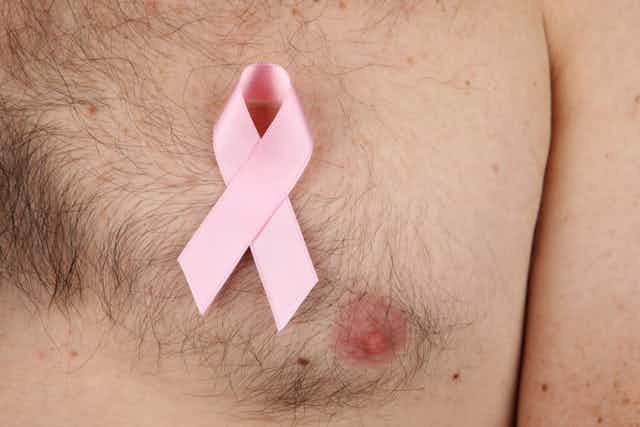Breast cancer is the most common cancer in the UK and the leading cancer in women worldwide. Approximately 150 cases are diagnosed in the UK every day – that’s one every 10 minutes. Breast cancer does not discriminate. The illness is undeterred by age, ethnicity, socioeconomic status, sexuality, or even sex. Yes, men get breast cancer, too – although you wouldn’t necessarily think so from much of the breast cancer awareness material around.
Incidence among men is low: there are approximately 390 new cases in UK men presenting each year compared to around 54,800 women. Consequently, breast cancer in men is consistently overlooked within both lay and expert health and care systems. This is despite the fact that breast cancer is responsible for proportionally more male deaths annually than some men’s cancers, including penile and testicular forms – 22% of men diagnosed with breast cancer die, compared to 21% of those with penile and 2.5% of those with testicular.
Prognosis for men is similar to that for women, yet outcomes among male patients are typically poorer due to reduced illness awareness and late disease detection. Five-year survival rates vary depending on the stage of the disease at diagnosis, but they are generally poorer for men than women.
Fe/male breast cancer
Clinical diagnosis of and methods used to treat breast cancer are currently the same for men and women, as it is assumed that the sexes share some anatomical and oncological similarities. But unlike research with women, large scale studies are comparatively scarce due to the relative rarity of breast cancer in men, and to date, there are no randomised control trials with men published.
The management of male patients and recommendations for treatment are therefore based largely on female data, despite little evidence validating the effectiveness of treatment options used with women in men. Further, recent research claims that breast cancer in men is not wholly the same, biomedically, as the disease in women. In 2016, researchers at Guy’s Hospital London reported key differences in epidemiological risk factors, tumour types, molecular profiling and responses to treatments.
Such findings pose important implications for treating breast cancer in men and illustrate why the illness warrants greater research attention. If the methods used to treat men are inadequate it could have grave consequences for them, even death. But this could be avoided with appropriate interventions.
Male marginalisation
But the more insidious effects of this gender imbalance occur socially. Because although breast cancer is not a sex-specific cancer, it is consistently gendered as a “women’s illness”. High-profile awareness-raising advocacy and activism around breast cancer in women has, over time, led to a reinforced misconception that it only affects women.
The explicit gendering of breast cancer serves as a barrier to men. It deters them from seeking prompt professional care and social support, and increases body image concerns. Men are rarely visible and scarcely discussed within breast cancer-focused communications – and even when the illness receives attention in male-dominated arenas, it is typically feminised. Many English Football and Premier League teams, for example, host breast cancer awareness fixtures, where the home team plays in a pink strip and supporters are encouraged (through the use of flyers and half-time talks) to help women to spot signs and symptoms sooner. The risk to men is seldom mentioned at such events.
Evidence suggests many survivors of breast cancer, men included, struggle to identify with the non-inclusive nature of “pink ribbon culture”. Related movements – such as “Race for Life”, an annual charitable event, in which men are excluded from participating – foster marginalisation and disempowerment of those, like men, who are at the breast cancer periphery. This affects their psychological response to the illness.
Men with breast cancer consistently report feeling marginalised, most commonly within cancer care systems, and by female patients and survivors. They often find themselves on the fringe of optimal care and support, causing them to feel alienated and emasculated.
Next steps
In the last few years, as part of my PhD research, I have interviewed men from across the UK living with, and beyond, a breast cancer diagnosis. My aim is to gain understanding about how men make sense of breast cancer and masculinity, and how this influences their adjustment to the illness.
I have found that the conceptualisation of breast cancer as feminine opposes dominant ideas of what it means to be a man. This threatens the identities of, and has complex ramifications for, affected men. The marginalisation of men with breast cancer poses additional difficulties for them to contend with beyond the primary cancer challenge. It undeniably influences their sense of self, affecting how they think and behave as men, and as sexual and social beings, during and beyond the illness episode.

October is breast cancer awareness month, when those affected by breast cancer – directly or indirectly – supposedly unite to raise public consciousness of the serious health threat and to promote breast health. Men – who are arguably the least risk-aware – remain underrepresented, ill-informed and sidelined by current approaches. Greater breast cancer equality is clearly needed.
Several things could be done to improve equality and men’s breast cancer experiences. Clinical settings should be redressed to appear more gender and culturally neutral. This may help to foster greater patient inclusivity. Linked to this, increasing the visibility of men in patient resources, visual displays in clinical waiting areas and at dedicated events would help improve men’s sense of identity and belonging. Shared patient resources should be developed which clearly signpost male-specific needs and concerns (separate literature could unintentionally isolate men further).
Men’s needs and experiences should be made more visible in clinical and support staffs’ training materials in order to improve knowledge and understanding of breast cancer in men, and staff-patient interactions. Ensuring that men have a voice and opportunities to be heard is key. Men should be encouraged to take part in clinical studies and to engage more with support services. Excluding men from participating in cancer awareness events is not advisable. If a holistic rethinking of breast cancer is to emerge, the inequities facing affected men need to be confronted.

